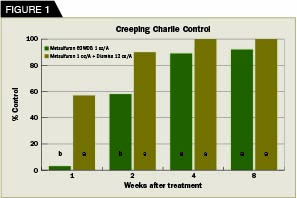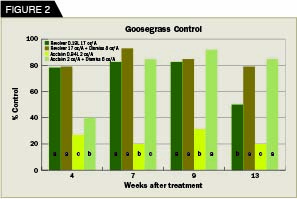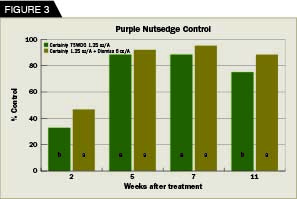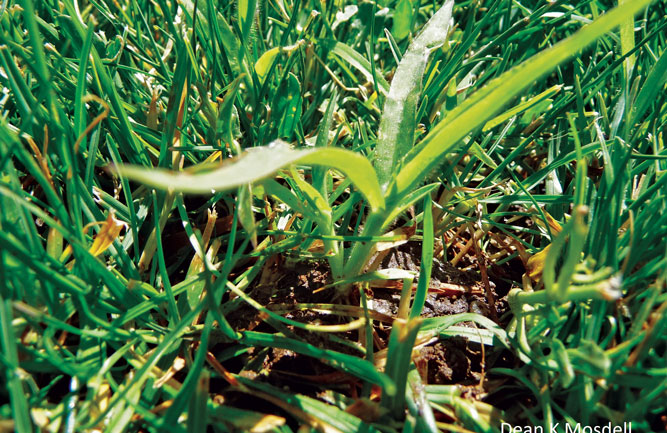Heat up the tank: Include a spray mix for broader, faster weed control
As a university researcher and one who frequently makes agronomic recommendations, I’m often asked, “Dr. McCarty, what can I add to my spray mix to heat things up?” This can be translated to mean, “What can I add to my tank-mixture to provide quicker and better weed control?”

Creeping Charlie (also known as ground ivy) control is hastened when Dismiss 4L
(12 oz/acre) is added to metsulfuron (1 oz/acre). Dissimilar letters at a particular rating date indicate statistical difference at the 0.05 level of probability as determined by Fisher’s protected LSD. Credit: Bert McCarty
Over the years, many products have been promoted to provide this added control, including various wetting agents, adjuvants, stickers, emulsifiers, soaps, seed oils, vegetable oils, humectants, humic acids, ammonium sulfate/nitrate, urea and others. Although these products do sometimes improve the performance by being synergistic or additive, they can also become antagonistic and/or cause the spray formulation to be incompatible, meaning the spray tank components separate out (will not stay in suspension) or worse, cause turf burn.
However, one potentially positive additive to most postemergence herbicide spray mixtures is Dismiss 4L from the FMC Corporation. Dismiss contains sulfentrazone, a member of the aryl triazinone herbicide family. It has both pre- and post-emergence activity. The majority of preemergence activity is on small seeded broadleaf weeds plus some grass and sedge weeds while postmergence activity is greatest on sedges and kyllinga. When used as a preemergence herbicide, Dismiss is absorbed by roots of germinating weeds. Postemergence activity is by foliar absorption, which causes rapid desiccation and necrosis of treated tissue. Dismiss controls plants by inhibiting an enzyme (called protox or PPO) of chlorophyll biosynthesis in chloroplasts, eventually causing cell membrane disruption.

Adding Dismiss to postemergence grass control products helps accelerate control and better extended control compared to not adding it. Shown are Acclaim Extra 0.94L at 2 oz/acre and Revolver 0.19L at 17 oz/acre with and without Dismiss 4L at 8 oz/acre for quicker and better long-term goosegrass control. Dissimilar letters at a particular rating date indicate statistical difference at the 0.05 level of probability as determined by Fisher’s protected LSD. Credit: Bert McCarty
Since its introduction to the turfgrass market, Dismiss has carved out a niche, especially for postemergence yellow nutsedge and kyllinga control. However, from my research and experiences, it can be added to just about any postemergence weed control application. Some reasons for adding Dismiss would be to provide more rapid weed control, improve weed control at lower air temperatures and increase the range of weed species that are controlled. In our what-have-you-done-for-me-lately society, people become impatient when they hire someone to control weeds or use herbicides and don’t see almost immediate results. How many times have you heard the accusation that only water was applied since results are not almost instantaneous?
Though numerous wonderful herbicides exist in the turfgrass market, many of these are slow acting. Some herbicides may take two to four weeks to show activity, as these often disrupt normal food production/accumulation in plants, basically starving treated weeds to death. This slow-to-work characteristic is manifested when temperatures are cool (<50 F). Dismiss, being more of a contact herbicide, is influenced more by available sunlight vs. warmer temperatures, offers activity within hours of application. Treated plants start to turn off-color, leaf margins are damaged, and plants start to wilt and eventually lead to shoot burndown. Figure 1 demonstrates hastened control of creeping Charlie (also known as ground ivy) when Dismiss is added to metsulfuron (several trade names). For example, one week after treatment, weed control was less than 5% without Dismiss, while it was almost 60% when Dismiss was added to metsulfuron. This trend was also evident two weeks after treatment where metsulfuron alone provided almost 60% control but when tank-mixed with Dismiss, 90% control was achieved.

Purple nutsedge control is hastened and longer-lasting when Dismiss 4L is added at 6 oz/acre to Certainty 75WDG at 1.25 oz/acre. Dissimilar letters at a particular rating date indicate statistical difference at the 0.05 level of probability as determined by Fisher’s protected LSD. Credit: Bert McCarty
Dismiss 4L also offers additive control to many problematic weeds in turf, including many broadleaves, grasses and sedges/kyllingas. Adding 2 to 6 oz/acre as a spray tank additive provides quicker herbicide activity as previously discussed, but also “heats up” the tank-mixtures in terms of wider and more complete weed control. This is especially true for tough-to-control weeds such as perennial broadleaf weeds, grasses such as goosegrass and many sedges and kyllingas. For example, when controlling goosegrass (Figure 2), adding Dismiss to either Acclaim Extra (fenoxaprop-p-ethyl) or Revolver (foramsulfuron) again hastened control and also helped provide better long-term results. When tank-mixed with Dismiss, Revolver provided better goosegrass control after 13 weeks than without it (Figure 2). With Acclaim, adding Dismiss provided quicker and better short- and long-term goosegrass control. Figure 3 demonstrates quicker and longer term purple nutsedge control when Dismiss was tank-mixed with Certainty (sulfosulfuron).
So, if you are looking for a spray addition to “heat things up,” Dismiss often not only provides a wider spectrum of weed control, but is also less temperature dependent than other products. Mixtures with Dismiss often work much quicker, providing an increased sense of security that the applicator is indeed treating the problem and dismissing the idea that only water has been applied.
Bert McCarty, Ph.D., is a professor of turfgrass science at Clemson University and can be contacted at bmccrty@clemson.edu.










